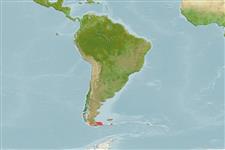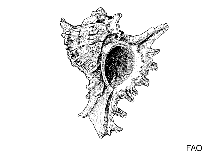Xymenopsis muriciformis (King & Broderip, 1832)
| Native range | All suitable habitat | Point map | Year 2050 |

|
| This map was computer-generated and has not yet been reviewed. |
| Xymenopsis muriciformis AquaMaps Data sources: GBIF OBIS |
Upload your photos
Google image | No image available for this species;
drawing shows typical species in Muricidae.
Google image | No image available for this species;
drawing shows typical species in Muricidae.
Classification / Names Common names | Synonyms | CoL | ITIS | WoRMS
Gastropoda | Neogastropoda | Muricidae | Trophoninae
Environment: milieu / climate zone / depth range / distribution range Ecology
Benthic; depth range 0 - 170 m (Ref. 83435). Temperate; 53°S - 55°S, 71°E - 62°E (Ref. 83435)
Distribution Countries | FAO areas | Ecosystems | Occurrences | Introductions
Southeast Pacific and Southwest Atlantic: Chile, Falkland and Argentina.
Length at first maturity / Size / Weight / Age
Maturity: Lm ? range ? - ? cm Max length : 4.8 cm DL male/unsexed; (Ref. 83435)
Maximum depth from Ref. 87801. It is found on rocky substrates like gravel, cobble and even on corals, fronds and holdfasts of brown algae (Ref. 87801), like forests of Macrocystis pyrifera (Ref. 92889), from the lower intertidal to a depth of 170 m (Ref. 87801).
Life cycle and mating behavior Maturity | Reproduction | Spawning | Eggs | Fecundity | Larvae
This species has egg capsules wherein embryos develop completely within them and emerges as crawling juveniles. The capsules are attached to hard substrates like rocks or empty shells (Ref. 87801).
Main reference
References | Coordinator | Collaborators
Rosenberg, G. 2009. (Ref. 83435)
IUCN Red List Status (Ref. 130435)
CITES status (Ref. 108899)
Not Evaluated
CMS (Ref. 116361)
Not Evaluated
Threat to humans
Human uses
| FishSource |
Tools
More information
Internet sources
BHL | BOLD Systems | CISTI | DiscoverLife | FAO(Publication : search) | Fishipedia | GenBank (genome, nucleotide) | GloBI | Gomexsi | Google Books | Google Scholar | Google | PubMed | Tree of Life | Wikipedia (Go, Search) | Zoological Record
Estimates based on models
Price category
(Ref. 80766):
Unknown.



